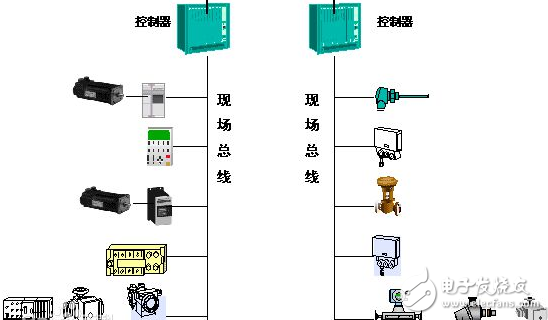**What is a Fieldbus?**
A fieldbus is a digital, two-way communication network used at the production site to connect intelligent field devices with automated control systems. It operates at the lowest level of the industrial control hierarchy and serves as a link between the field and the upper-level networks.
Fieldbus is typically a low-bandwidth network designed for control applications, enabling communication between devices and the enterprise's internal and external networks. It provides a comprehensive communication platform that supports real-time data exchange and integration across different levels of an organization.

**Fieldbus Control System**
The software component plays a crucial role in a fieldbus control system. This includes configuration, maintenance, simulation, monitoring, and device management tools. The user interface (MMI) is often developed first, allowing users to define function blocks, set parameters, and configure the network. During operation, the system continuously collects and processes data, optimizing control logic, triggering alarms, and generating reports.
**Fieldbus Measurement System**
This system enables multi-variable, high-performance measurements, offering advanced computing capabilities within measuring instruments. Digital signals ensure high resolution, accuracy, and resistance to interference. These devices can also monitor equipment status and adjust process conditions dynamically.
**Equipment Management System**
It provides diagnostic, operational, and manufacturing information about connected devices, supporting both maintenance and performance tracking.
**Bus System Computer Service Module**
This module uses a client-server model, where servers act as data sources, and clients process the data. Servers may run on minicomputers or mainframes, while clients operate on PCs, ensuring efficient resource use and task execution.
**Database**
The database stores and manages large volumes of dynamic data, supporting real-time access and cross-system sharing. It is essential for handling continuous changes in industrial equipment parameters and maintaining high-speed communication.
**Network System Hardware and Software**
Hardware includes hosts, servers, gateways, hubs, and user computers. Software such as NetWarc, LAN Manager, and Vines supports network operations, while server operating systems like Linux, Windows NT, and OS/2 manage communications and protocols.
**Bus Classification**
There are over 40 types of fieldbuses globally, used in industries such as process control, medicine, and aerospace. Common classifications include RS-485, HART, and Fieldbus networks.
**RS-485 Network**
Popular for its simplicity and cost-effectiveness, it is widely supported by many instruments. It remains a dominant choice in low-end industrial networking due to its affordability and versatility.
**HART Network**
Developed by Emerson, HART combines digital signals with 4–20 mA current. However, it is not fully open, requiring membership for full access. While widely used, its limited speed and complexity may reduce its long-term appeal.
**Fieldbus Network**
Fieldbus is a key technology in modern automation, enabling digital, multi-node communication. It allows decentralized control and has led to the development of Fieldbus Control Systems (FCS). Despite its potential, no single standard dominates, with multiple protocols coexisting.
**Features and Disadvantages**
Fieldbus offers open standards, interoperability, and distributed control. It reduces installation costs, improves reliability, and provides flexible integration. However, issues like data delay, packet loss, and inconsistent timing can complicate control logic and affect system performance.
**What is Industrial Ethernet?**
Industrial Ethernet is a variant of commercial Ethernet designed for industrial environments. It meets the demands of real-time communication, reliability, and environmental resilience. It extends Ethernet into the field level, bridging the gap between automation and IT systems.
**Comparison of Industrial Ethernet and Traditional Ethernet Networks**

**Operational Requirements**
Industrial environments require robust products that withstand extreme temperatures, humidity, dust, and electromagnetic interference. Devices must be explosion-proof, durable, and compatible with low-voltage power supplies. Installation should be simple and modular for easy replacement.
**Main Standards**
Industrial Ethernet adapts Ethernet for industrial control, using specialized protocols. Examples include EtherNet/IP, PROFINET, and HSE. These standards support real-time communication, network management, and seamless integration with higher-level systems.
**Problems to Be Solved in Industrial Control**
Industrial Ethernet must meet specific requirements, including real-time performance, fault tolerance, high reliability, and strong security. It must also support distributed control, efficient communication, and compatibility with existing systems.
**Advantages**
Industrial Ethernet offers wide application, low cost, high speed, rich resources, strong sustainability, and easy integration with information systems. It supports long-distance transmission, bus power supply, and secure communication, making it ideal for modern industrial automation.
Interactive whiteboard,COB LED display,touch screen display,LCD whitboard,meeting tablet
Shanghai Really Technology Co.,Ltd , https://www.really-led.com